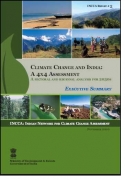/topics/biodiversity
Biodiversity
Immediate moratorium sought on clearances for large dams in northeast India - Press release by Krishak Mukti Sangram Samiti (Assam)
Posted on 14 Dec, 2010 10:56 PM23rd November 2010, New Delhi
- Seeking a moratorium on clearances for large dams in Northeast India
- Withdrawal of clearances granted to 2000 MW Lower Subansiri, 1750 MW Demwe Lower & 1500 MW Tipaimukh dams
- Future steps on hydropower projects and dams only after full, prior and informed consent of people in the region
- Protect the Brahmaputra river basin as a cultural and ecological endowment
Lake 2010: Wetlands, Biodiversity and Climate Change, Bangalore
Posted on 14 Dec, 2010 10:51 AMLake 2010: Wetlands, Biodiversity and Climate Change
Theme: Wetlands Conservation and Management
Climate change and India - A sectoral and regional analysis for 2030s by the Indian Network for Climate Change Assessment (INCCA)
Posted on 05 Dec, 2010 10:45 AM This report prepared by the Indian Network for Climate Change Assessment (INCCA) provides an assessment of impact of climate change in 2030s on four key sectors of the Indian economy, namely agriculture, water, natural ecosystems & biodiversity and health in four climate sensitive regions of India, namely the Himalayan region, the Western Ghats, the Coastal Area and the North-East Region. This is the for the first time that such a comprehensive, long term assessment has been undertaken based on rigorous scientific analysis for the 2030s (all previous assessments were for the 2070s and beyond).
This report prepared by the Indian Network for Climate Change Assessment (INCCA) provides an assessment of impact of climate change in 2030s on four key sectors of the Indian economy, namely agriculture, water, natural ecosystems & biodiversity and health in four climate sensitive regions of India, namely the Himalayan region, the Western Ghats, the Coastal Area and the North-East Region. This is the for the first time that such a comprehensive, long term assessment has been undertaken based on rigorous scientific analysis for the 2030s (all previous assessments were for the 2070s and beyond).
Water security for India: The external dynamics - An IDSA Task Force Report
Posted on 01 Dec, 2010 08:44 PMThe report by Institute for Defence Studies and Analyses is premised on the fact that India is facing a serious water resource problem and is expected to become 'water stressed' by 2025 and 'water scarce' by 2050. It raises fundamental questions about the forces driving water demand and the political dynamics of riparian relations, both in terms of hindrances and opportunities, amongst states in the subcontinent. Rivers, a crucial source of water resources, physically link upstream and downstream users and at the same time create barriers.
Palak Dil Lake - Mizoram
Posted on 26 Nov, 2010 03:00 PMThe Mizoram state has three types of (natural) lakes: valley lakes, tectonic/landslide lakes and artificial reservoirs, but the only lake of significance is Palak Dil, which is a natural lake in a depression in the hills. Palak Dil may possibly be a combination of valley and tectonic lakes. Locally in Mizoram, lakes are called dils. There are many such dils scattered all over the state, but they are tiny pools or marshy depressions such as Rengdil, Tamdil and Mampui Dil (Choudhury 2002). The Palak Lake is situated within the Mara Autonomous district Council, which is a region inhabited by the Mara Tribe. The Maras are distinct from the majority Mizos and in the Mara language the Palak Lake is referred to as Pala Tipa.
News roundup (8-15 November 2010) :"India proposes a new emission check system" and News round-up on the floods
Posted on 17 Nov, 2010 06:08 PMClimate Change
Environment
"Gujarat farmers fight against climate change: Adopt technoloxxgy to conserve resources and maximize benefits" : News roundup (15-21 October 2010)
Posted on 22 Oct, 2010 11:25 AMClimate Change
Environmental Pollution and Management - A Civil Engineering Course under the National Programme on Technology Enhanced Learning
Posted on 13 Oct, 2010 10:32 PMThis Civil Engineering Course under the National Programme on Technology Enhanced Learning (NPTEL) on the broad subject of Environmental Pollution and Management is being carried out by Indian Institute of Technology’s and the Indian Institute of Science, Bangalore as a collaborative project supported by the Ministry of Human Resource Development (Government of India) to enhance the quality of engineering education in the country, by developing curriculum based video and web courses. In these web based lectures, the authors have developed the subject in detail and in stages in a student-friendly manner. The broad group of Environmental Pollution and Management is structured into modules on the following topics:
The First Indian Biodiversity Congress (IBC) 2010, CISSA, Thiruvananthapuram
Posted on 01 Oct, 2010 02:04 PMIndian Biodiversity Congress (IBC) 2010
Theme: Biodiversity and Development: Mainstreaming Biodiversity into Policy-Making
Water security vs national security published in Third Concept September 2010 : Countries that share a river face a higher probability of engaging in military disputes
Posted on 28 Sep, 2010 10:15 AMThere has been growing public and policy preoccupation in recent years with potential climate impacts on water security in the wake of the worsening risk of global warming. In 1991, then–UN secretary general Boutros Boutros-Ghali pronounced that “the next war will be fought over water, not politics.” In 2001, Kofi Annan warned that “fierce competition for fresh water may well become a source of conflict and wars in the future.” And present UN secretary general Ban Ki-Moon has argued that the ongoing Darfur crisis grew at least in part from desertification, ecological degradation, and a scarcity of resources, foremost among them water. Apart from this chorus of concern, many policy scholars have asserted that, as population growth and economic development raise pressures on demand and environmental pressures degrade supplies, resource scarcities could precipitate violent international conflicts, with shared rivers an especially dangerous flashpoint.





